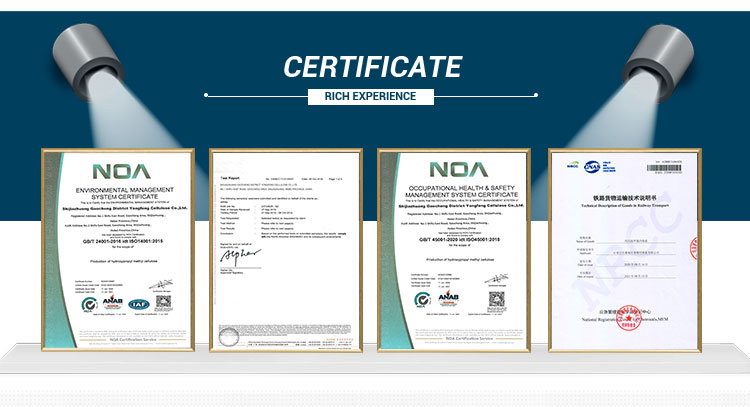Understanding the Role of HPMC in Chemical Adhesives
Hydroxypropyl Methylcellulose (HPMC) is a versatile cellulose ether widely used in various industrial applications, especially in the production of chemical adhesives. This non-ionic compound is derived from natural cellulose and modified to enhance its properties for specific uses. In this article, we will explore the significance of HPMC in chemical adhesives, its benefits, and the applications in which it excels.
Properties of HPMC
HPMC is prized for its unique set of properties that make it suitable for use in adhesives. It is water-soluble and forms a viscous solution when mixed with water, which allows it to be easily incorporated into various adhesive formulations. Some of the key properties of HPMC include
1. Thickening Agent HPMC acts as a thickening agent, increasing the viscosity of adhesive formulations, which helps in improving application control and reducing drippage.
2. Film-Forming Ability Once dried, HPMC forms a stable film that enhances the adhesive's bonding strength and durability. This property is crucial for applications requiring long-lasting bonds.
3. Water Retention HPMC has excellent water retention properties, which helps to keep the adhesive workable for a longer period, extending the open time and allowing for adjustments during application.
4. Non-Toxic and Environmentally Friendly As a plant-derived product, HPMC is non-toxic and considered safe for various applications, including those in the food and pharmaceutical industries.
Benefits of Using HPMC in Chemical Adhesives
The incorporation of HPMC in chemical adhesives offers several advantages
- Improved Adhesive Performance HPMC enhances adhesion to different substrates by providing a stable and cohesive bond. This is particularly beneficial in construction and woodworking applications, where reliable bonding is essential.
chemic adhes hpmc

- Versatility HPMC can be tailor-made to achieve specific properties, making it suitable for a wide range of bonding applications, from woodworking adhesives to tile adhesives and beyond.
- Compatibility HPMC is compatible with various resins and polymers, allowing manufacturers to create adhesive formulations with improved functionalities.
- Ease of Use HPMC-based adhesives often require minimal preparation and can be applied easily, making them user-friendly for both professionals and DIY enthusiasts.
Applications of HPMC in Chemical Adhesives
HPMC is prevalent in several industries due to its beneficial properties. Some common applications include
1. Construction Industry HPMC is used in cement-based adhesives for tiles, stone, and ceramics, ensuring strong bonds even in wet conditions. Its water-retentive properties help maintain the adhesive’s effectiveness during initial setting.
2. Woodworking In woodworking, HPMC enhances the performance of adhesives, providing strong and durable bonds essential for furniture and cabinetry.
3. Automotive Sector HPMC is utilized in automotive adhesives for its excellent adhesion and resistance to environmental factors, which is crucial in ensuring the longevity of bonds under varying conditions.
4. Pharmaceuticals In the pharmaceutical sector, HPMC is used as a binder in the formulation of tablets and as a component in medical adhesives due to its non-toxic nature.
Conclusion
HPMC is a key ingredient in the formulation of chemical adhesives due to its numerous advantageous properties, including its thickening ability, film-forming characteristics, and water retention. Its versatility and compatibility with various materials make it a valuable component across a range of industries, from construction and woodworking to pharmaceuticals. As the demand for high-performance adhesives continues to grow, HPMC will undoubtedly remain an essential material in developing innovative adhesive solutions. Its environmentally friendly profile further enhances its appeal in an increasingly eco-conscious market, making it a product worth considering for future adhesive formulations.
-
Rdp Powder: Key Considerations for Wholesalers in the Building Materials IndustryNewsJul.08,2025
-
Key Considerations for Wholesalers: Navigating the World of Hpmc - Based ProductsNewsJul.08,2025
-
Hpmc Detergent: Key Considerations for WholesalersNewsJul.08,2025
-
Key Considerations for Wholesalers: China Hpmc For Tile Adhesive, Coating Additives, Concrete Additives, and MoreNewsJul.08,2025
-
Crucial Considerations for Wholesalers: Navigating the World of Construction MaterialsNewsJul.08,2025
-
Key Considerations for Wholesalers Sourcing Additive For Cement, Additive For Concrete, Additive For Putty from Additive Manufacturer Shijiazhuang Gaocheng District Yongfeng Cellulose Co., Ltd.NewsJul.08,2025




